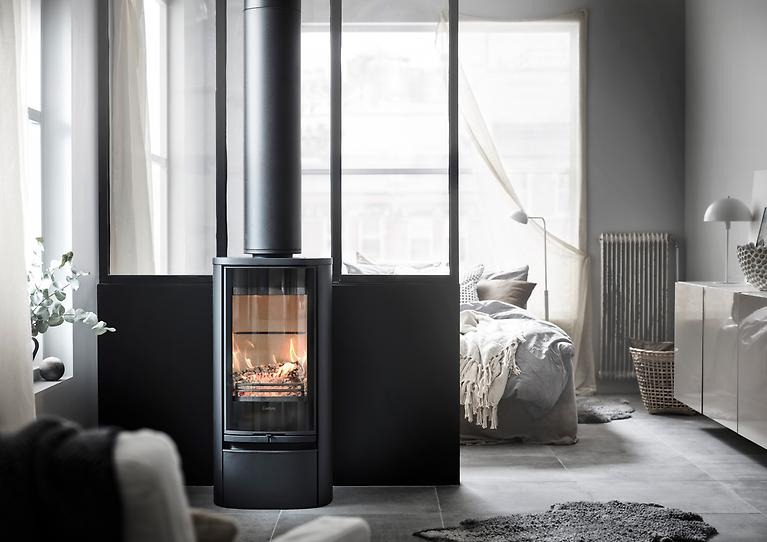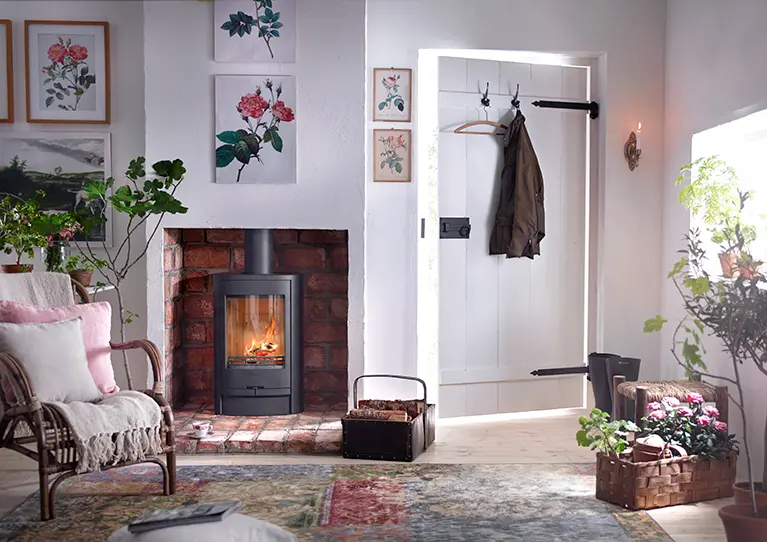Why choose a Wood burner?
%20Contura-810G-Style-black-chimney.jpg)
There are few things in life more comforting and mesmerising than the long, lazy flames and crackling sound of a freshly lit wood fire. However, there is some confusion around the impact of wood burning stoves on the environment and the efficiency and sustainability of firewood as a fuel source.
With the continued cost-of-living crisis and high energy prices, it is important to be aware of different heating options that can help save money on energy bills in the longer-term and that allow you to take back some control of your fuel supply.
When used and maintained correctly, a wood burner that meets government regulations – an Ecodesign stove - is a completely viable option for homeowners looking to upgrade an old stove, replace an open fireplace, better heat a living space, or even switch to wood as the main energy source.
A wood burner will heat a home efficiently, can help save on energy bills, and, when compared with open fires or older stove models, will significantly reduce particulate emissions. Firewood is also a highly efficient and low-carbon energy source, so installing a compliant wood burner can provide a sustainable domestic heating solution.
It’s important to follow best practice and choose the right stove for your space and the right fuel options to ensure the best possible performance of a wood burning stove.
Why is wood a good fuel option?
Unlike coal or natural gas, wood is a low-carbon, sustainable and renewable energy source. This means that burning wood results in a relatively small net release of carbon dioxide into the atmosphere, which is then re-absorbed when new trees grow. This effectively balances out the combustion of bioenergy.
Switching from smokeless or mineral fuels to burning wood reduces the reliance on energy from power stations used to power central heating and contributes to a reduction in carbon emissions, thus reducing the carbon footprint of your home in the long-term.
Unlike fossil fuels such as coal, crude oil and natural gas, wood is a renewable energy source. A renewable resource is defined as a natural resource which can be replenished to replace the portion depleted by usage.
Wood is renewable in that a tree cut for fuel will naturally be replaced by a younger tree that grows or is planted in its place.
Most firewood is produced from thinning the forest to provide space, nutrition and light for thicker, more established trees to prosper. Localised coppicing helps to ensure ‘low fuel miles’ as wood is transported to areas nearby, within a 30 to 100 mile radius, rather than sourced from forests abroad.
Is wood burning efficient?
Using firewood contributes to fuel independence as it can nearly always be sourced locally, which means it extremely efficient in fuel miles terms and those purchasing firewood are also supporting the local economy.
In the case of rural properties that do not necessarily want to heat all spaces at all times, local space heating using firewood is the most efficient heating solution.
Just two logs per hour are required to keep a wood burner going and, when compared to an open fire for example, a wood burning stove is 60 percent more efficient at heating the home as heat transfer is convected into the room rather than being lost up the chimney.
Should I upgrade my open fire?
A wood burning stove is far more efficient than an open fireplace. Using less wood, it is cheaper to run, leads to a better fuel economy and significantly improves both indoor and outdoor air quality.
Choosing a modern, cleaner burning, Ecodesign log burner will both minimise emissions and enhance efficiency.
Open fire vs wood burner: The stats
1. An Ecodesign wood burning stove reduces particulate emissions by 90 percent compared to a traditional open fire and 80% compared to a 10 year old stove.
2. Two logs of similar characteristics will burn for up to one hour in a wood burning stove, compared to only 15 minutes on an open fire.
3. Compared to open fires, Ecodesign stoves reduce the emission of:
• Organic Gaseous Carbon compounds (OGCs) by 70 percent
• Nitrous Oxide (NOx) 34 percent
• Carbon Monoxide (CO) by 33 percent
4. Migrating from an open fireplace to a flue connected to a stove will halve the deemed air loss from the room.
5. 80 percent of the heat generated by a wood burning stove is convected and radiated into the room, compared to only 20% in the case of an open fire.

